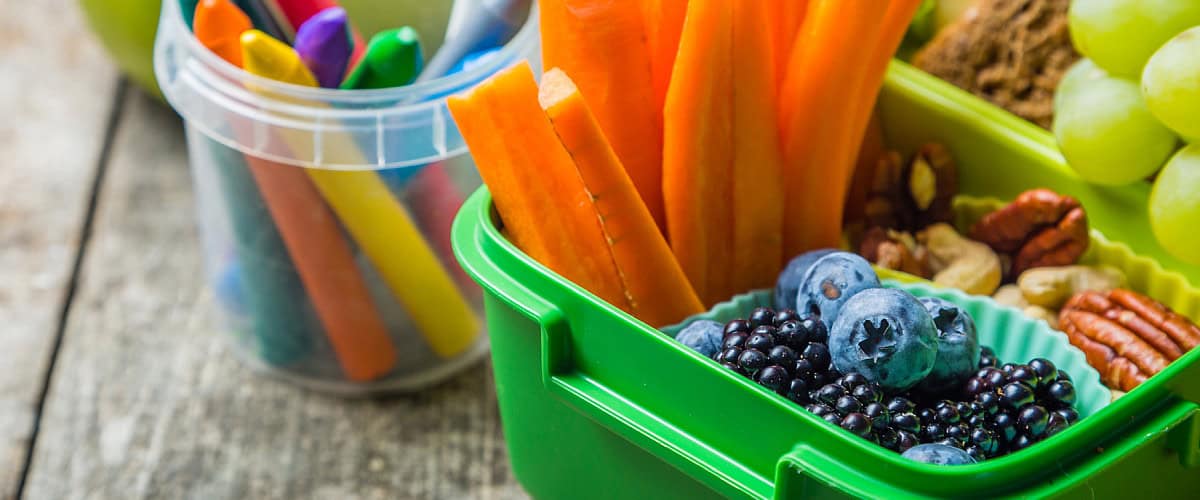Does it feel like your kids are always snacking? After-school snacks, before-dinner snacks, snacks at home, and snacks on the road. If snack time feels like all the time in your family, you’re not alone.
Snacks actually make up over 25% of the calories kids eat during an average day. So, how often should kids really be snacking? And what should they be snacking on? These are the types of questions our dietitians hear from parents every day.

Emily Simo, Registered Dietitian
That’s why, in this installment of our “What’s a Parent to Do?” blog series, we reached out to Emily Simo, an Aramark Registered Dietitian working in one of the country’s largest school districts. We asked Emily to help tackle the question of how to balance snacking with mealtimes so kids can get the nutrition they need.
“Kids are constantly growing and developing, and with that they need more nutrition, even more than their parents need sometimes,” says Emily. “But snacking is an essential part of making sure kids stay fueled and get the nutrients they need to learn and develop.”
Q: Do kids really need to snack?
Snacking between meals is normal and healthy for kids, who have smaller stomachs than adults and need to eat more frequently. Most kids eat about three meals and up to four snacks a day.
Snacks help kids get the nutrition they need for brain and body development, and can help kids learn better at school and maintain their energy throughout the day’s activities.
Emily sees snack time as another great opportunity to have kids eat the wholesome and nutritious foods they need as part of an overall balanced diet. So, the answer to this one is an unequivocal yes! Snacking is a healthy part of growing up.
Q: How often and when should kids snack?
 Emily says there’s really no hard and fast rule about how often and when kids should snack.
Emily says there’s really no hard and fast rule about how often and when kids should snack.
“Let their bodies and hunger cues guide you,” she says. A good approach is to offer kids a snack a couple hours after a meal and a few hours before the next one.
“If children are snacking more frequently than usual, it may be because they’re growing or because they haven’t had enough to eat during the day,” says Emily. “Try not to pre-judge, whether it’s the right time or the wrong time for a snack, or how many snacks are the ‘right’ number.”
Instead, she recommends parents start by being curious about why their child may be hungry and what they may be hungry for. She suggests taking a mental note of when they want a snack and why. “This can help you plan for their best snack time,” she says.
Q: What makes a healthy snack?
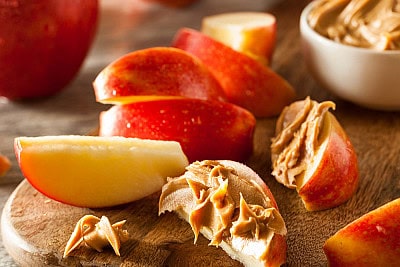 Think of a snack as a mini-meal and try to include wholesome nutritious foods whenever possible.
Think of a snack as a mini-meal and try to include wholesome nutritious foods whenever possible.
Emily recommends parents provide snacks with at least two of the three main “macro-nutrients”—carbohydrates, protein, and healthy fats. Combining food types this way gives snacks more staying power and nutrients.
“If kids just snack on carbs, the snack won’t stick with them as long. But carbs and protein, or carbs and healthy fats (which often go along with lean protein) give them more long-lasting energy,” says Emily.
Crackers (a carb) and cheese (protein) is a great example. An apple and peanut butter is another.
“What’s important is to combine different foods together, and also to have a variety of options for your kids,” Emily says.
Emily is a pragmatist. She knows that kids aren’t always going to ask for the healthiest snacks parents want them to have. She counsels dialogue.
For example, when your child is hungry, ask them what they think would give them energy and help them feel full until the next meal. After they snack ask, “how did you know you were full?” These types of curiosity questions can help kids get in tune with their body.
The same goes for portion sizes. Pick a starting point, she recommends.
For example, start with a half cup of goldfish crackers and a handful of cheese cubes—and see how your child does. She suggests letting them know they can have more, and also that they don’t have to finish what you give them. See how they do, then adjust as needed as you both get a better understanding for their snacking needs.
Talk about it as you go, so you both learn more about what works best.
Q: What’s the difference between a snack and a treat and how do I balance the two?
 Emily prefers not to use the word “treat.” When we distinguish some foods as treats and others as healthy, it can just make kids want the treat even more. If it’s “off limits,” it can make that snack feel like something they want to sneak, which isn’t a good thing.
Emily prefers not to use the word “treat.” When we distinguish some foods as treats and others as healthy, it can just make kids want the treat even more. If it’s “off limits,” it can make that snack feel like something they want to sneak, which isn’t a good thing.
“Try to avoid ‘good food’ or ‘bad food’ language,” she recommends. If your child wants an occasional cookie for a snack, she advises letting them have it, but pairing it with a glass of milk or a cheese stick to add some protein and other nutrients, and to keep them fuller longer.
Or, she suggests, ask your child whether that cookie should wait until after dinner and talk to them about whether a different snack might be better to keep them going until dinner time.
Again, she suggests starting with questions, for example, “What are you hungry for and why?”
Q: What healthy snacking habits and behaviors should parents keep in mind?
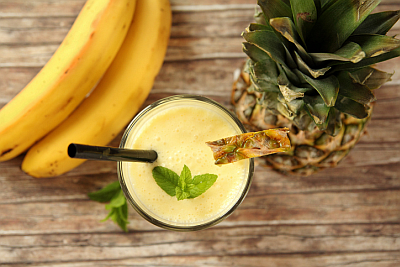 When snacking happens at home, it’s a good opportunity for parents to make a variety of nutritious snacks readily available and easy to access.
When snacking happens at home, it’s a good opportunity for parents to make a variety of nutritious snacks readily available and easy to access.
For example, wash grapes or berries and keep them in an easy-to-open storage container. Peel and slice carrots or cut celery to keep crunchy snacks on hand.
Emily also suggests that kids snack in a quiet, calm, distraction-free environment when possible. It’s better if kids don’t snack while watching TV because that can interfere with them tuning into their bodies and may contribute to “mindless snacking,” she says.
Finally, parents can model snacking behavior for their kids, choosing snacks that are good for the whole family. “Good snacking habits at home can cross over into your child’s snack habits away from home,” says Emily.
Q: Should snacking habits change with age?
“Sometimes a child in elementary school might eat more than high schooler,” says Emily, and that’s okay. Again, it’s kid specific. Let your child be the guide.
There’s not an exact age-to-number-of-snacks-needed chart. Keep in mind, though, that kids who are going through a growth spurt or ones who are very active may need more snacks.
Q: What about when I’m in a time pinch? Are healthier packaged snacks okay?
Pre-packaged snacks can be super-convenient, especially when you’re rushing from one activity to the next. It’s fine to mix prepacked snacks with fresh ones.
Parents shouldn’t feel guilty about giving their kids packaged snacks if that’s what works best for their family. What’s important is to offer a variety of snacks over time and to lean towards nutritious snacks whenever possible, she says.
Q: Is a bedtime snack okay?
If your child says they’re hungry right before bed, Emily recommends letting them have a snack. Not sleeping well can sometimes be tied to not eating enough the day before.
Try a glass of milk and a piece of whole wheat toast or a hard-boiled egg or some oatmeal.
Don’t worry that letting your child eat before bed could keep them awake.
“Our bodies never turn off,” says Emily, “so even if a snack happens two minutes before bed, kids’ bodies should be able to both digest and sleep.”
If the bedtime snack becomes a habit, think about what they’re eating for their other meals and snacks so you can move towards a place where the bedtime snack isn’t needed as often.
Q: What are some of the best snacks to keep around the house?
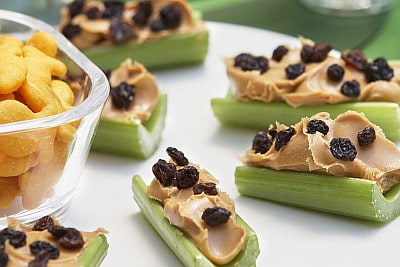 Plan ahead to stock up on a wide variety of snack options.
Plan ahead to stock up on a wide variety of snack options.
Tasty, nutritious snack options to keep around include trail mix, dried fruit (without added sugars), whole gain pretzels, low-fat cheese, lower sugar yogurts, lightly salted corn chips and salsa, hard boiled eggs and lightly salted or unsalted nuts.
Try pairing nuts and fruits for a lightly salty and sweet combo. For example, strawberries and almonds, or orange slices and pistachios.
Emily likes to always have apples on hand because they last in the refrigerator for weeks. Other great staples include cheese, crackers, yogurt, and granola.
Fun, healthy snacks that require a little more work (but not much) include:
- Celery sticks stuffed with peanut or almond butter and sprinkled with raisins
- Peeled bananas dipped in yogurt, rolled in cereal and frozen
- Granola and yogurt with fresh blueberries
- Fruit kabobs –cheese cubes and grapes on skewers
- A whole grain waffle topped with yogurt and fruit slices
- Peanut butter spread on apple slices
- A smoothie made with yogurt and frozen fruit
- Oatmeal with nuts and dried fruit
- Cut up veggies and hummus
- Whole grain crackers and cheese
- Avocado toast on whole wheat bread
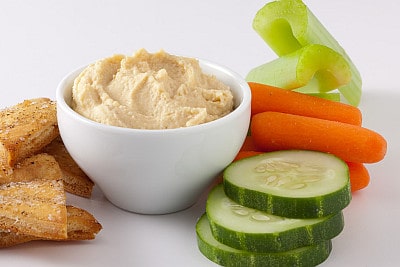 Emily reminds us that snack time shouldn’t be stressful. It’s a time to grab something that kids will like while also getting them more of the nutrient-dense whole foods that we know they need.
Emily reminds us that snack time shouldn’t be stressful. It’s a time to grab something that kids will like while also getting them more of the nutrient-dense whole foods that we know they need.
“Every snack doesn’t have to be perfect,” she says, “but a good snack is a great way to fuel their day and feed their potential!”
Emily Simo is a Registered Dietitian and part of Aramark’s Nutrition Network—a community of dietitians within Aramark Student Nutrition. The Nutrition Network connects and engages Aramark Student Nutrition RDNs and other nutrition experts in ways that benefit school students, parents and caregivers, and their district’s health and wellbeing initiatives.
Note: Since everyone’s health history and nutritional needs are so different, please make sure that you talk with your doctor and a registered dietitian to get advice about the diet and exercise plan that‘s right for you.

